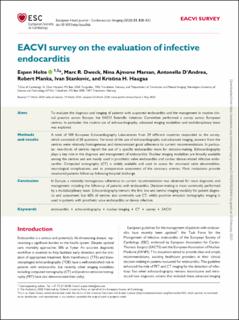| dc.contributor.author | Holte, Espen | |
| dc.contributor.author | Dweck, Mark R. | |
| dc.contributor.author | Marsan, Nina Ajmone | |
| dc.contributor.author | D'Andrea, Antonello | |
| dc.contributor.author | Manka, Robert | |
| dc.contributor.author | Stankovic, Ivan | |
| dc.contributor.author | Haugaa, Kristina | |
| dc.date.accessioned | 2021-02-23T13:02:00Z | |
| dc.date.available | 2021-02-23T13:02:00Z | |
| dc.date.created | 2020-08-10T14:58:33Z | |
| dc.date.issued | 2020 | |
| dc.identifier.citation | European Heart Journal-Cardiovascular Imaging. 2020, 21 (8), 828-832. | en_US |
| dc.identifier.issn | 2047-2404 | |
| dc.identifier.uri | https://hdl.handle.net/11250/2729844 | |
| dc.description.abstract | Aims
To evaluate the diagnosis and imaging of patients with suspected endocarditis and the management in routine clinical practice across Europe, the EACVI Scientific Initiatives Committee performed a survey across European centres. In particular, the routine use of echocardiography, advanced imaging modalities and multidisciplinary team was explored.
Methods and results
A total of 100 European Echocardiography Laboratories from 29 different countries responded to the survey, which consisted of 20 questions. For most of the use of echocardiography and advanced imaging, answers from the centres were relatively homogeneous and demonstrated good adherence to current recommendations. In particular, two-thirds of centres report the use of a specific endocarditis team for decision-making. Echocardiography plays a key role in the diagnosis and management of endocarditis. Nuclear imaging modalities are broadly available among the centres and are mainly used in prosthetic valve endocarditis and cardiac device-related infective endocarditis. Computed tomography (CT) is widely available and used to assess for structural valve abnormalities, neurological complications, and to preoperative assessment of the coronary arteries. Most institutions provide structured patients follow-up following hospital discharge.
Conclusion
In Europe, a relatively homogenous adherence to current recommendation was observed for most diagnostic and management including the follow-up of patients with endocarditis. Decision-making is most commonly performed by a multidisciplinary team. Echocardiography remains the first line and central imaging modality for patient diagnosis and assessment, but 60% of centres also commonly use CT, whilst positron emission tomography imaging is used in patients with prosthetic valve endocarditis or device infection. | en_US |
| dc.language.iso | eng | en_US |
| dc.publisher | Oxford University Press | en_US |
| dc.rights | Navngivelse 4.0 Internasjonal | * |
| dc.rights.uri | http://creativecommons.org/licenses/by/4.0/deed.no | * |
| dc.title | EACVI survey on the evaluation of infective endocarditis | en_US |
| dc.type | Peer reviewed | en_US |
| dc.type | Journal article | en_US |
| dc.description.version | publishedVersion | en_US |
| dc.source.pagenumber | 828-832 | en_US |
| dc.source.volume | 21 | en_US |
| dc.source.journal | European Heart Journal-Cardiovascular Imaging | en_US |
| dc.source.issue | 8 | en_US |
| dc.identifier.doi | 10.1093/ehjci/jeaa066 | |
| dc.identifier.cristin | 1822554 | |
| dc.description.localcode | VC The Author(s) 2020. Published by Oxford University Press on behalf of the European Society of Cardiology. This is an Open Access article distributed under the terms of the Creative Commons Attribution License (http://creativecommons.org/licenses/by/4.0/), which permits unrestricted reuse, distribution, and reproduction in any medium, provided the original work is properly cited. | en_US |
| cristin.ispublished | true | |
| cristin.fulltext | original | |
| cristin.qualitycode | 2 | |

